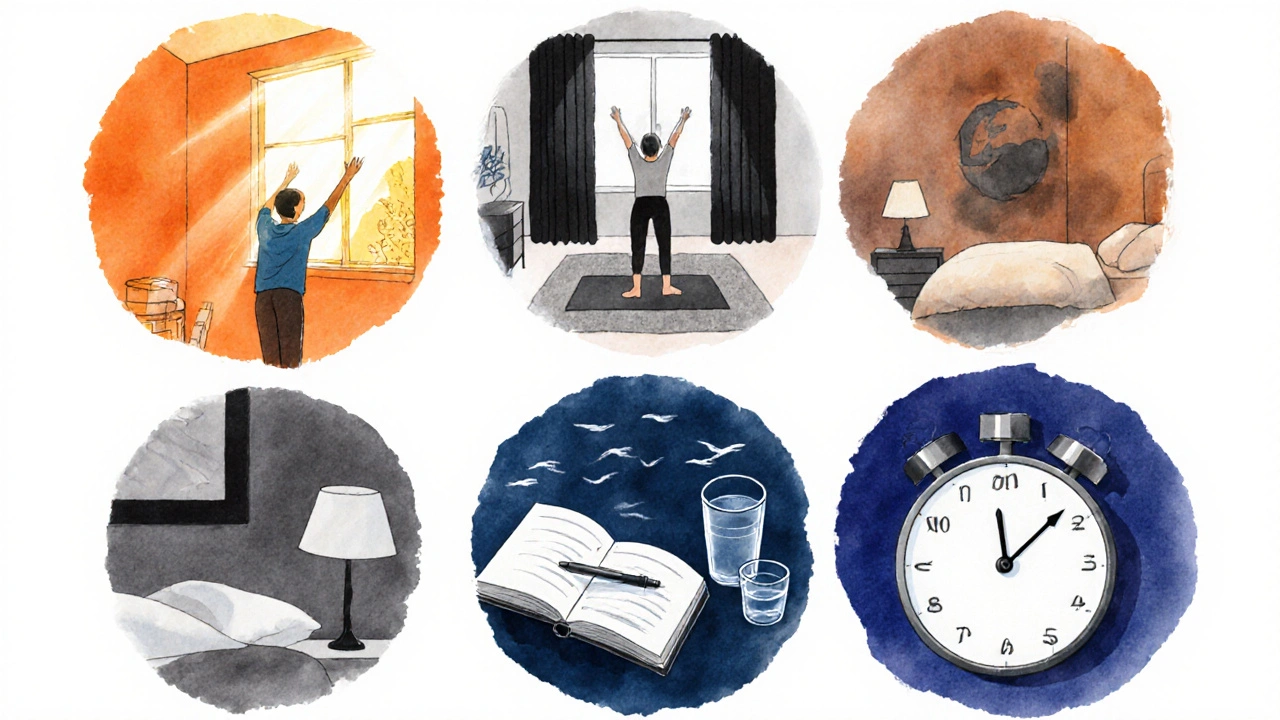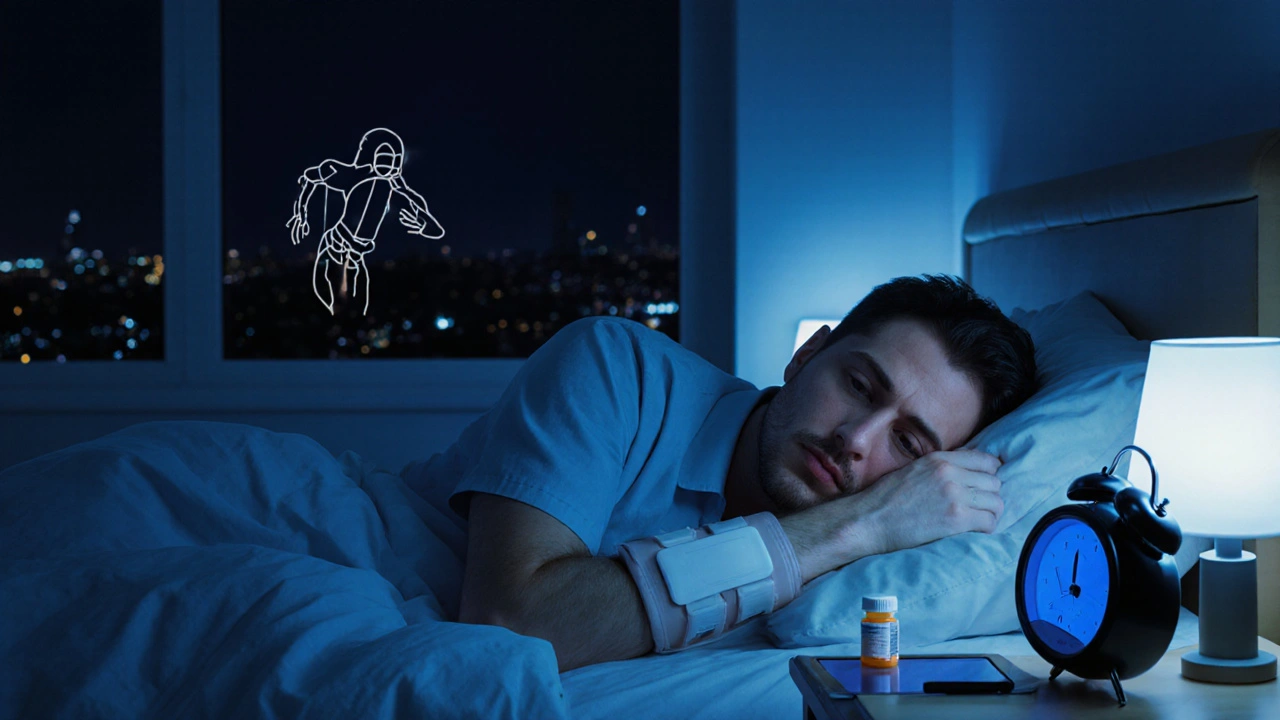MS Sleep Quality Improvement Calculator
Your Sleep Quality Improvement Potential
Enter your values and click "Calculate Sleep Improvement Score" to see your personalized recommendations.
Living with multiple sclerosis is challenging enough, but when restless nights pile on, the whole picture gets hazier. Poor sleep quality can amplify pain, worsen fatigue, and even speed up disease progression. The good news? Simple, science‑backed tweaks can turn sleepless evenings into restorative rest, giving your body the break it desperately needs.
Quick Takeaways
- Identify and treat the three biggest sleep disruptors for MS: pain, medication timing, and circadian misalignment.
- Adopt a consistent bedtime routine that includes dim lighting, limited screens, and a cool bedroom.
- Try evidence‑based interventions such as CBT‑I, light therapy, and moderate evening exercise.
- Track sleep patterns with a journal or wearable to spot trends before they become chronic.
- Consult a neurologist or sleep specialist if insomnia persists for more than three weeks.
Why Sclerosis Messes with Your Sleep
Research shows that up to 70% of people with multiple sclerosisa chronic autoimmune disease that attacks the protective covering of nerves report sleep disturbances. The culprits aren’t just the obvious symptoms; they’re a web of interrelated factors.
Fatiguea persistent sense of exhaustion that isn’t relieved by rest is both a cause and a consequence of poor sleep. When you can’t stay asleep, your body can’t recharge the energy reserves needed to combat daily MS fatigue.
Many disease‑modifying drugs, especially steroids and certain disease‑modifying therapies, can interfere with the production of melatonina hormone that signals the body it’s time to sleep. Low melatonin levels throw off the circadian rhythmthe internal 24‑hour clock that regulates sleep‑wake cycles, making it harder to fall asleep at night.
Key Sleep Disruptors for MS Patients
- Pain and spasticity - Night‑time muscle cramps trigger micro‑awakenings.
- Bladder urgency - Frequent trips to the bathroom fragment sleep.
- Medication side effects - Some treatments promote insomnia, others cause daytime drowsiness.
- Emotional stress - Anxiety about disease progression fuels insomnia, often diagnosed as insomniadifficulty falling or staying asleep.
- Disrupted light exposure - Irregular schedules or excessive evening screen time suppress melatonin.
Step‑by‑Step Sleep‑Improvement Plan
- Establish a fixed sleep‑wake schedule. Go to bed and rise at the same time, even on weekends. Consistency reinforces the circadian rhythm.
- Optimize the bedroom environment. Keep the room cool (around 18‑19°C), dark, and quiet. Use blackout curtains or a sleep mask to block stray light.
- Limit screen exposure. Shut down phones, tablets, and TVs at least 60 minutes before bedtime. Blue‑light filters or ‘night mode’ can reduce melatonin suppression.
- Mind your evening meals. Avoid large, heavy meals, caffeine, and alcohol within three hours of sleep. A light protein‑rich snack (e.g., Greek yogurt) can steady blood sugar.
- Incorporate gentle evening exercise. Light yoga, stretching, or a short walk boosts sleep depth without raising core temperature too much.
- Try light therapy. Bright light exposure (10,000 lux) for 20‑30 minutes each morning helps reset the circadian clock, especially for those who nap late in the day.
- Consider Cognitive Behavioral Therapy for Insomnia (CBT‑I). This structured program tackles maladaptive thoughts and habits around sleep. Multiple trials show CBT‑I improves sleep efficiency by up to 15% in MS cohorts.
- Review medication timing. Talk to your neurologist about shifting stimulant‑like drugs to earlier in the day or using extended‑release formulations that wear off by bedtime.
- Track sleep patterns. Use a simple journal or a wearable (e.g., Fitbit, Oura) to record bedtime, wake time, night awakenings, and daytime naps. Patterns reveal hidden triggers.

Intervention Comparison Table
| Intervention | Primary Benefit | Evidence Level (MS studies) | Ease of Adoption |
|---|---|---|---|
| CBT‑I | Improves sleep efficiency, reduces insomnia thoughts | High (randomized controlled trials) | Moderate - requires therapist or digital program |
| Morning Light Therapy | Resets circadian rhythm, boosts daytime alertness | Medium (clinical pilots) | Easy - 20min daily with a light box |
| Melatonin Supplement | Facilitates faster sleep onset | Low‑Medium (small cohort studies) | Easy - 1‑3mg 30min before bed |
| Evening Stretch/Yoga | Reduces muscle cramps, promotes relaxation | Medium (observational reports) | Easy - 10‑15min routine |
| Medication Timing Review | Minimizes stimulant side‑effects at night | High (neurology guidelines) | Variable - depends on prescription |
Managing Daytime Fatigue Without Sacrificing Night Rest
When fatigue hits hard, the temptation is to nap endlessly. Short, strategic naps (15‑20 minutes) can restore alertness without entering deep sleep, which otherwise makes it harder to fall asleep later. Pair a brief nap with a cup of green tea for a mild caffeine boost that wears off before bedtime.
Energy budgeting is another practical tool. Identify your most demanding tasks (e.g., work meetings, physical therapy) and schedule them during your natural peak hours-usually mid‑morning for most MS patients. Reserve low‑energy periods for activities like reading or gentle stretching.
When to Seek Professional Help
If you’ve tried the steps above for three weeks and still wake up multiple times, feel unrefreshed, or notice worsening MS symptoms, it’s time to bring in a specialist. A sleep study (polysomnography) can uncover hidden sleep‑apnea, periodic limb movements, or REM‑behavior disorders-conditions that are more prevalent in the MS population.
Additionally, ask your neurologist about evaluating your current disease‑modifying therapy for sleep‑related side effects. In some cases, a switch to a medication with a more neutral sleep profile can make a world of difference.
Quick Checklist for Better Sleep Tonight
- Set alarm for the same wake‑up time tomorrow.
- Turn off screens at least 60 minutes before bed.
- Dim lights and lower thermostat to ~18°C.
- Do a 10‑minute gentle stretch routine.
- Take 1mg melatonin if you struggle to fall asleep (consult doctor first).
- Write down any nighttime awakenings in a journal.
Frequently Asked Questions
Can MS medication cause insomnia?
Yes. Certain disease‑modifying drugs, especially steroids and some oral agents, can stimulate the central nervous system or alter melatonin production, leading to difficulty falling asleep. Discuss timing adjustments or alternative formulations with your neurologist.
Is napping harmful for MS patients?
Short naps (15‑20 minutes) can boost alertness without disrupting nighttime sleep. Longer naps that enter deep sleep stages may make it harder to fall asleep later and can worsen insomnia.
How does CBT‑I differ from regular therapy?
CBT‑I is a targeted program focusing on sleep‑related thoughts and behaviors. It includes stimulus control, sleep restriction, and cognitive restructuring, usually over 6‑8 weekly sessions, either in‑person or via reputable digital platforms.
Should I use melatonin every night?
Melatonin can be helpful for occasional sleep onset problems, but long‑term nightly use should be discussed with a doctor to ensure it doesn’t mask underlying issues or interact with your MS meds.
What light exposure is best for resetting my sleep clock?
Bright white light (10,000 lux) for 20‑30 minutes each morning, within the first hour after waking, is most effective. Avoid bright screens after sunset to prevent melatonin suppression.


Comments
The epistemological scaffolding underpinning contemporary sleep hygiene paradigms is riddled with reductionist fallacies, and this article egregiously perpetuates them.
First, the reduction of multifactorial MS symptomatology to a simplistic checklist betrays a lack of clinical nuance.
Second, the purported efficacy of light therapy is presented without a granular discussion of photopic intensity thresholds, which is a glaring omission.
Third, the authors cavalierly endorse melatonin supplementation despite the paucity of longitudinal data in demyelinating cohorts.
Fourth, the recommendation to “dim the lights” ignores the circadian intricacies mediated by intrinsically photosensitive retinal ganglion cells.
Fifth, the narrative neglects the pharmacokinetic interactions between disease-modifying therapies and hypnotics.
Sixth, the suggestion of “short naps” is a deus ex machina that fails to account for sleep inertia.
Seventh, the advice to track sleep with wearables overlooks the algorithmic opacity of proprietary sleep-stage detection.
Eighth, the absence of a structured CBT‑I protocol reduces the therapeutic arsenal to anecdotal speculation.
Ninth, the article’s tone vacillates between paternalistic admonition and superficial optimism, which undermines credibility.
Tenth, the reliance on lay terminology betrays an elitist disdain for professional discourse.
Eleventh, the omission of gender-specific symptom profiles reflects a myopic research lens.
Twelfth, the emphasis on environmental modifications discounts the neurobiological underpinnings of MS-related fatigue.
Thirteenth, the lack of discussion on comorbid sleep apnea is a critical oversight.
Fourteenth, the article’s graphical interface distracts from substantive content.
Fifteenth, the closing checklist reduces complex pathophysiology to a bullet‑point hymn of platitudes.
In sum, the piece is an exercise in intellectual laziness masquerading as patient empowerment.
I find the content substantially lacking in depth.
The article is mostly correct, but there are some small errors. For example, the section on melatonin says it should be taken “30 minutes before bed,” yet it does not mention that dosage should be adjusted for age. Also, the table of interventions repeats the word “Primary Benefit” twice. These minor issues could be fixed easily.
Wow, this piece really hits home. As someone juggling MS flare‑ups and relentless fatigue, I’ve tried a few of these tips and they actually made a difference.
The morning light exposure was a game‑changer; I felt more awake during the day and slept better at night.
Even the simple habit of turning off screens early helped calm my mind.
It’s refreshing to see a guide that actually acknowledges the emotional roller‑coaster we ride.
Glad you found something that works! 🙂 Consistency is key – set an alarm for the same bedtime and stick to it. If you ever feel the routine slipping, just remember that a tiny push today prevents a massive slump tomorrow. Keep tracking those night awakenings; the data will guide you to the next tweak.
You've got this!
Excellent rundown! I’d add that the optimal bedroom temperature is around 65°F (18‑19°C) – it promotes deeper REM cycles.
Also, consider a brief breathing exercise before lights out; it can lower heart rate and improve sleep onset latency.
💡 Great points, Fred! I’d throw in a 🌞 morning sun ritual – 10‑minutes on the balcony works wonders. And don’t forget a cozy bedtime playlist; soothing sounds can melt away tension. 🎶
I’ve been observing the conversation, and it’s clear that many of these suggestions are low‑cost and low‑risk. Implementing them gradually may be the most sustainable route.